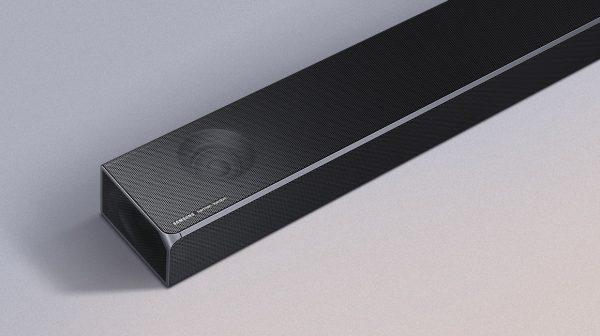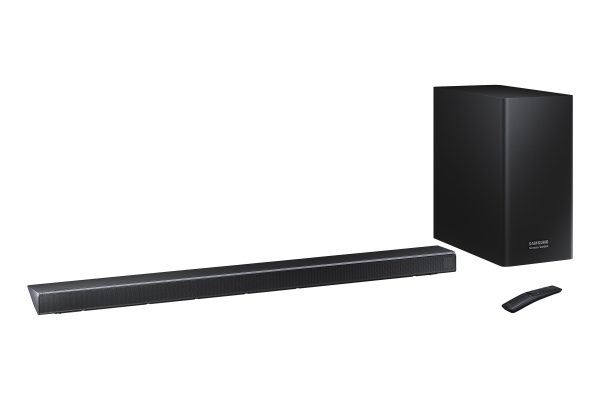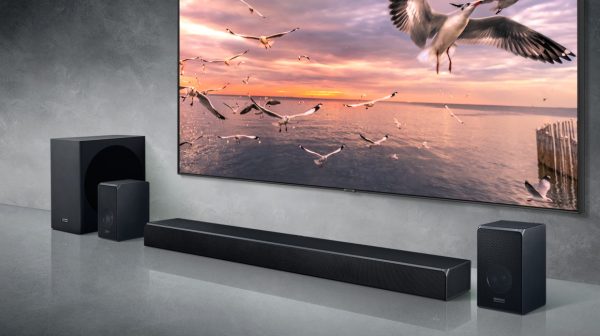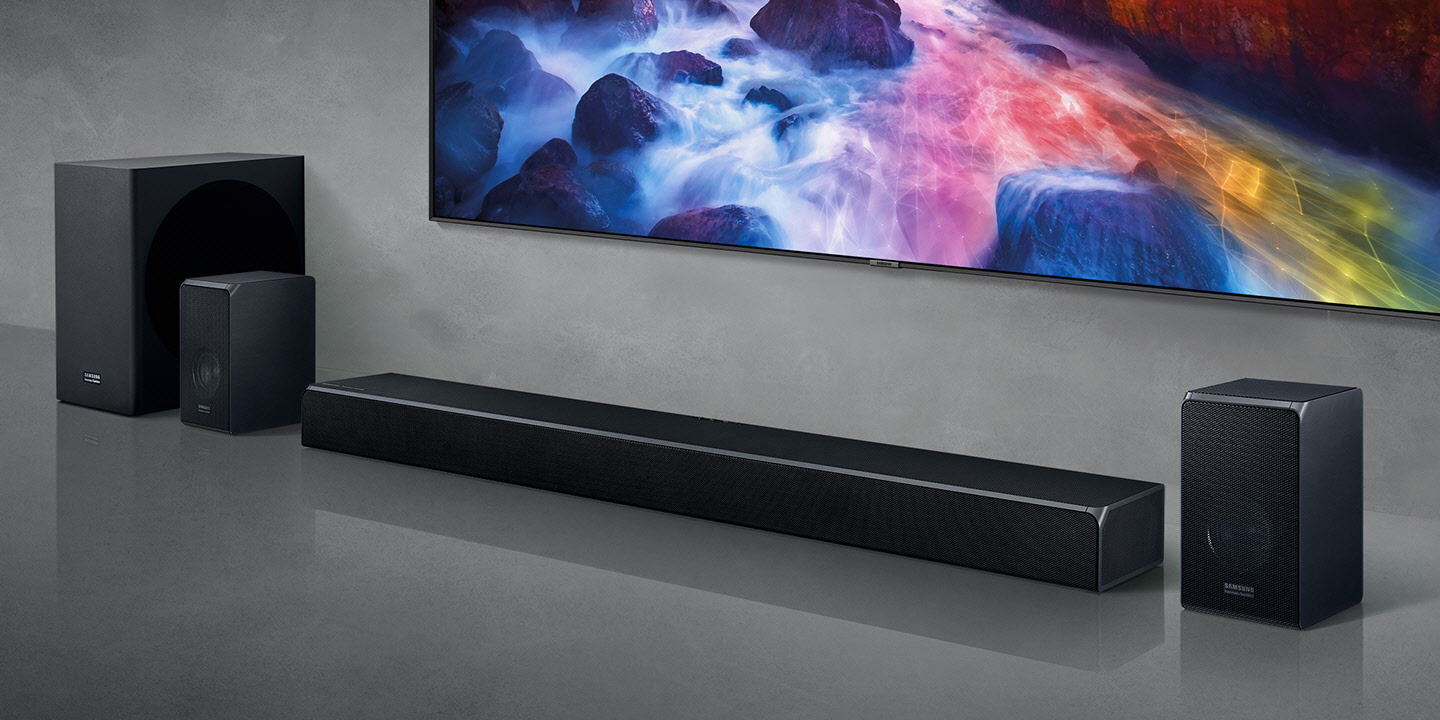SAMSUNG HW Q90R / HW Q70R soundbars
Q90R:
+ Surprisingly expansive sound, with good Atmos effects from 7.1.4 configuration; subwoofer’s bass goes deep, with good presence; music playback is enjoyable, with a good wrap-around effect when in “surround” mode; good connectivity.
– Despite expansive sound, never quite truly enveloping; Atmos effects somewhat diffused; for music, bass a little monotonous and no precise stereo soundstage; in “standard” mode, sound bound to the physical constraints of the soundbar; although well built, finish of cabinets comes off as a little “cheap” looking for the price; could have done with more HDMI inputs.
Sound: 8/10
Value: 7/10Q70R:
+ Surprisingly expansive sound, with good Atmos effects from the 3.1.2 configuration; bass from subwoofer’s bass is deep enough, with good presence; music playback is enjoyable, with reasonable width when in surround mode;, good connectivity.
– Not surprisingly, not as “big” sounding as its bigger brother and does not project as wide a soundfield; lack of the rear speakers mean that there isn’t any real “rear” effects; midrange a little coarse at higher volumes; only one HDMI input means that you need to build your system with care.
Sound: 7/10
Value: 8/10
AFTER acquiring Harman International in 2017, Samsung has been busy incorporating the expertise from Harman Kardon into its products. The soundbar market has expanded considerably in recent years, driven by developments in flatscreen TVs which call out for better audio solutions than what can be packaged in their now seemingly impossibly slimline enclosures.
As an electronics behemoth, Samsung has been keen to show what it can do and the Harman DNA has come in handy in tuning the sound of its various products, from the earbuds packaged with the Galaxy smartphones all the way to these Soundbars and smart speakers.
The editor has asked me to compare two of Samsung’s latest soundbar offerings – the Q70R and Q90R, so named to match their current line of QLED TVs.

Q90R:
The Q90R is a direct descendant of the HW-N950, and indeed the bar itself and the surround speakers seem totally unchanged from a hardware perspective, but reportedly, the subwoofer module is an all new design. There are plenty of changes in the software though, and the new Q90R is altogether more capable as a result.
The hardware is impressive in itself – 17 drivers across the system are powered by 500W of amplification (though they decline to mention exactly how this is distributed) to give a true 7.1.4 channel Atmos and DTS:X capable system. The on-board DSP is used for time alignment, surround processing and EQ, but there is none of the beam-forming tricks like those from Yamaha. The system is rated from 34Hz to 17kHz – plenty of bandwidth for all its intended applications.
The main unit is a fairly long oblong bar (make sure you have enough space below your TV ), with the sole choice of a metallic dark grey finish Samsung calls “Carbon Silver”. The grilles are nice enough and the construction is solid, but for my taste, there is a bit too much smooth plastic in the rear to give it a truly premium look and feel, unlike the more tasteful textures used by Sonos in its Playbar and Beam soundbars. The surround units are fairly nondescript, but note that you should place them equidistant from your main listening point as there isn’t a way to adjust the output from them separately.

Set-up was fairly straightforward, with the soundbar going underneath my projector screen and the surround units behind my sofa. The subwoofer went in front. All the units come with Telefunken-style mains leads, though their length was a little short for my liking.
I did not need to re-link the wireless connections for the individual units as they were already linked from the factory, but if you should so require, there are the requisite buttons on each satellite unit.
I hooked up my Oppo UDP-205 4K Blu-ray player to HDMI 1 and an Apple TV 4K to HDMI 2. I also paired my iPad on Bluetooth (SBC codec only), and with the help of Samsung’s SmartThings app, I got the soundbar onto Wi-Fi to test Spotify Connect streaming. I connected my Optoma projector to the output of the soundbar, which features eARC, though I did not have the chance to test the eARC capability.
There is no calibration process embedded in this system, you have to use a pink noise generator and an SPL meter on your phone to balance the channels manually with the help of the supplied remote to adjust the various channels.

Q70R:
The Q70R is a similar looking unit, though not as long (1.1m) or as hefty in its cross section. The bar houses three speakers facing the front and another two firing upwards to give the “height” information for Dolby Atmos and DTS:X. The wireless subwoofer unit looks to be identical to the one that comes with the Q90R. The Q70R is based on the previous HW-N650 soundbar unit, but the performance and features have been enhanced, as well as being paired with the new subwoofer design.
Internally, there is 330 watts of amplification, though how this is distributed is also not disclosed. The subwoofer has a Telefunken style mains lead input, but the bar itself has a DC input and an accompanying power brick.
Tee Q70R also comes with an identical-looking remote control, but lacks the rear speaker units, of course.

I had to swap sources for the Q70R between the Oppo UDP 205 and the Apple TV4K on account of having only one HDMI input. Again, there is no automated set-up, and you need to dive into the menus to balance the output channels.
LISTENING
The testing done for both soundbars was principally as home theatre soundbar systems, though I also spent a good amount of time listening to music from the Apple TV, via Bluetooth and also via Spotify Connect. I also tried a Google Chromecast Ultra.
Music
Using the Samsung SmartThings App, I placed the soundbars on my home Wi-Fi network and the soundbars appeared on Spotify’s devices.
Q90R:
I began auditioning on the standard mode, which minimises processing. The sound was very likeable, with a good sense of energy and propulsion, especially on tracks such as Dire Straits’ Brothers in Arms (320kbps OGG Vorbis Spotify stream). Switching to more acoustic recordings such as Macy Gray’s Stripped, it became obvious that the soundstage was rather constrained to the bounds of the physical box.
Surround Mode unleashed the music from the confines of the bar (especially with the side-firing drivers coming into play), with the sound emanating from the upward-firing speakers of the satellites as well as the main bar.

This made for a much more enveloping sound, and was very enjoyable, though it must be said that there wasn’t really an accurate sound stage per se. Putting on some orchestral music (Karajan’s 1963 Beethoven Symphonies on Deutsche Grammophon) demonstrated this best – the sound comes from all around, but it’s quite difficult to pinpoint the sections of the orchestra.
Switching to the other modes made for distinctly different presentations, and are worth experimenting with, especially the adaptive mode which seems to prioritise human voices – good for narration or sports commentary.
Samsung has made good use of Harman’s expertise in tuning the speakers, making for an enjoyable listen, but the bass left a little to be desired – being a little “one note” and lacking in texture compared to the best subwoofer/speaker combos.

Q70R:
Repeating the same tracks with the Q70R, I was struck first by how well the little brother does in general, and that it sounded very much like the elder brother. The voicing obviously has a family sound. Again, as with the Q90R, I started out in standard mode, but found that I much preferred the surround mode to spread out the sound, even if at the expense of soundstaging, but even more so for a smaller sound bar, I feel that the trade-off favours the more “processed” mode.
Where it doesn’t quite measure up is in the wrap-around effect – the Q90R has the benefit of many more drivers and the rear speaker units to envelop the listener far more when listening to music.
Compared to my resident Sonos Beam soundbar, the Samsung definitely projects a wider and more expansive sound, but on balance, for music, I liked the voicing of the Sonos a little more – it sports a smoother, better integrated midrange.
Set-up was even easier as there were no rear units to plug into the mains, just the power brick for the bar and the subwoofer requiring power. Wireless pairing was already done, so there was no need to re-sync the units using the buttons on the bar and subwoofer.

As a an Atmos system:
Q90R:
Switching to the Oppo USD 205 as a source, spinning my collection of 4K Blu-ray discs, the Q90R came to its own. First up with The Martian, which has a great atmospheric sound track that makes good use of the height channels to bring Mars into your living room. Here, the Q90R switches to a dedicated Atmos mode. The decoding of the music and sound effects was well painted around the viewer. Tracking effects such as the rocket noises were easily discerned in the mix around the listener as well as above. There was plenty of energy and the subwoofer was more than up to the tasks of the subsonic rumbles in the sound track.
Another space movie, the reissue of Apollo 13, was equally well-rendered -the launch scenes and the seminal scene when Jim Lovell says, “Houston, we have a problem” sent chills up my spine.
I also tested the soundbar while listening to music and concert Blu-ray discs such as Diana Krall’s Live in Paris – the 5.1 DTS-MA soundtrack was a treat to listen to with her breathy vocals front and centre of the mix and the orchestra and accompanists spread throughout. Although fixing the exact locations of the instruments was not easy, the overall balance and flow of the music was enjoyable. The bass did show a tendency to become a little boomy – but something that could be gotten around by backing down the bass output on the handy remote.
Comparing to my resident 7.1.2 discrete speaker surround system (comprising KEF LS50s for left, centre and right, with Pioneer rears and sides, powered by an Arcam AVR390), it was clear that there are some shortcomings from the soundbar in terms of the absolute width as well as the “projection” of the sound and relative depth in the mix in various directions, but in all, the Q90R acquits itself well in this company.
Q70R:
Repeating the same scenes which I know well from my own AV system, again I was struck by how well the Q70R fares and is thus thoroughly enjoyable in its own right. Overhead effects were well portrayed, even with fewer upward firing drivers and there was a decent sense of width and separation in the multi-channel sound tracks.
Where it doesn’t quite match its bigger brother is obviously the lack of any real rear effects; not having side-firing drivers also limits the effect of width. The subwoofer acquits itself well again, going deep enough for most soundtracks, though it must be said that it did not integrate as well with the soundbar – there is a bit of a perceptual gap between the sub and the sound bar.
THE LAST WORD
The Q90R ticks all the boxes if you’re looking for a minimum fuss system with true Atmos 7.1.4 and minimal wiring. But at the asking price and if you have the space and ability to install a system with discreet speakers and an AV amp, there are probably gains to be had both in music playing as well as for movies. As such, it’s a matter of horses for courses – but I doubt if anyone will be disappointed by the Q90R.
I think that the Q70R overall is the better bet – for the difference in cost, the Q70R achieves its design goals of being even easier to set up and house under most modestly-sized TVs. With a performance which comes close in most respects to the Q90R, the Q70R represents much better value for money.
Gear
Optoma 4K UHD projector, Oppo UDP 205, Apple TV 4K, Google Chromecast Ultra. Comparison with an Arcam AVR 390, driving KEF LS50 speakers, Yamaha Atmos in ceiling speakers, Pioneer surround speakers, and REL T5 subwoofer.
Price: US$1,400 (HW-Q90R) / US$700 (HW-Q70R)
Malaysian price: RM6,499 / RM3,399
Review samples courtesy of Samsung Malaysia (1 800 88 9999) / Malaysian store locator.






Hi guy , I am very sure that my LG C9 OLED HDMI port earc can be connected to the Q90R Soundbar to output Dolby Atmos correctly by Netflix.
Hi! Can you use Chromecast to make the soundbar available on Google Home? Tks!